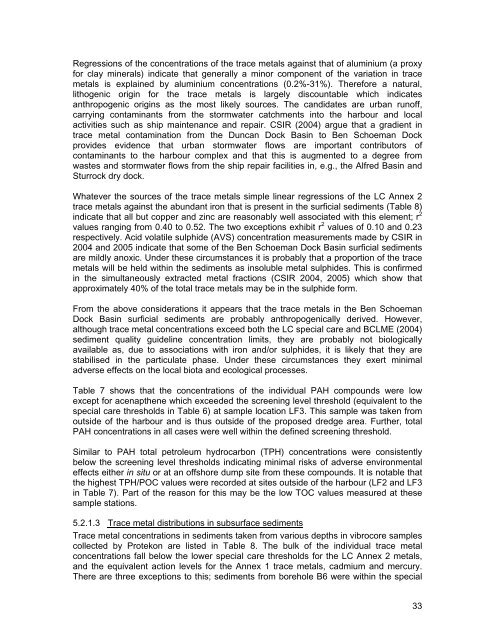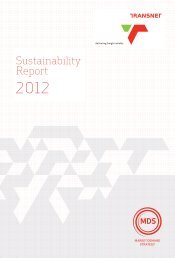BEN SCHOEMAN DOCK BERTH DEEPENING Specialist ... - Transnet
BEN SCHOEMAN DOCK BERTH DEEPENING Specialist ... - Transnet
BEN SCHOEMAN DOCK BERTH DEEPENING Specialist ... - Transnet
You also want an ePaper? Increase the reach of your titles
YUMPU automatically turns print PDFs into web optimized ePapers that Google loves.
Regressions of the concentrations of the trace metals against that of aluminium (a proxy<br />
for clay minerals) indicate that generally a minor component of the variation in trace<br />
metals is explained by aluminium concentrations (0.2%-31%). Therefore a natural,<br />
lithogenic origin for the trace metals is largely discountable which indicates<br />
anthropogenic origins as the most likely sources. The candidates are urban runoff,<br />
carrying contaminants from the stormwater catchments into the harbour and local<br />
activities such as ship maintenance and repair. CSIR (2004) argue that a gradient in<br />
trace metal contamination from the Duncan Dock Basin to Ben Schoeman Dock<br />
provides evidence that urban stormwater flows are important contributors of<br />
contaminants to the harbour complex and that this is augmented to a degree from<br />
wastes and stormwater flows from the ship repair facilities in, e.g., the Alfred Basin and<br />
Sturrock dry dock.<br />
Whatever the sources of the trace metals simple linear regressions of the LC Annex 2<br />
trace metals against the abundant iron that is present in the surficial sediments (Table 8)<br />
indicate that all but copper and zinc are reasonably well associated with this element; r 2<br />
values ranging from 0.40 to 0.52. The two exceptions exhibit r 2 values of 0.10 and 0.23<br />
respectively. Acid volatile sulphide (AVS) concentration measurements made by CSIR in<br />
2004 and 2005 indicate that some of the Ben Schoeman Dock Basin surficial sediments<br />
are mildly anoxic. Under these circumstances it is probably that a proportion of the trace<br />
metals will be held within the sediments as insoluble metal sulphides. This is confirmed<br />
in the simultaneously extracted metal fractions (CSIR 2004, 2005) which show that<br />
approximately 40% of the total trace metals may be in the sulphide form.<br />
From the above considerations it appears that the trace metals in the Ben Schoeman<br />
Dock Basin surficial sediments are probably anthropogenically derived. However,<br />
although trace metal concentrations exceed both the LC special care and BCLME (2004)<br />
sediment quality guideline concentration limits, they are probably not biologically<br />
available as, due to associations with iron and/or sulphides, it is likely that they are<br />
stabilised in the particulate phase. Under these circumstances they exert minimal<br />
adverse effects on the local biota and ecological processes.<br />
Table 7 shows that the concentrations of the individual PAH compounds were low<br />
except for acenapthene which exceeded the screening level threshold (equivalent to the<br />
special care thresholds in Table 6) at sample location LF3. This sample was taken from<br />
outside of the harbour and is thus outside of the proposed dredge area. Further, total<br />
PAH concentrations in all cases were well within the defined screening threshold.<br />
Similar to PAH total petroleum hydrocarbon (TPH) concentrations were consistently<br />
below the screening level thresholds indicating minimal risks of adverse environmental<br />
effects either in situ or at an offshore dump site from these compounds. It is notable that<br />
the highest TPH/POC values were recorded at sites outside of the harbour (LF2 and LF3<br />
in Table 7). Part of the reason for this may be the low TOC values measured at these<br />
sample stations.<br />
5.2.1.3 Trace metal distributions in subsurface sediments<br />
Trace metal concentrations in sediments taken from various depths in vibrocore samples<br />
collected by Protekon are listed in Table 8. The bulk of the individual trace metal<br />
concentrations fall below the lower special care thresholds for the LC Annex 2 metals,<br />
and the equivalent action levels for the Annex 1 trace metals, cadmium and mercury.<br />
There are three exceptions to this; sediments from borehole B6 were within the special<br />
33

















